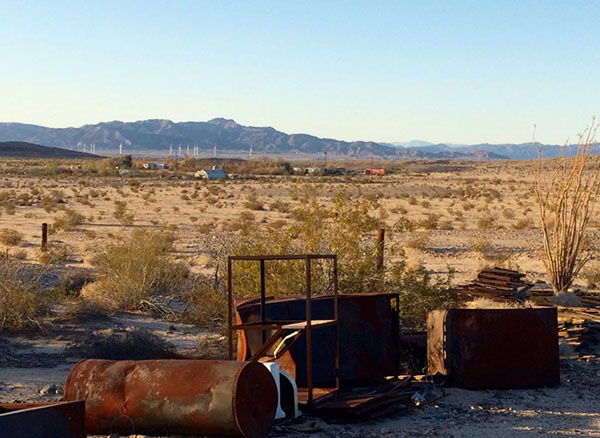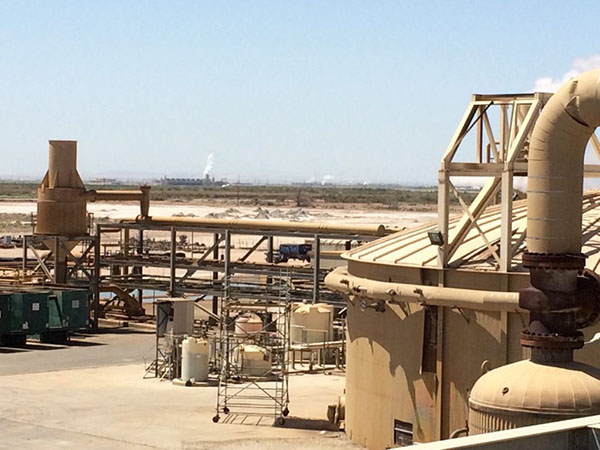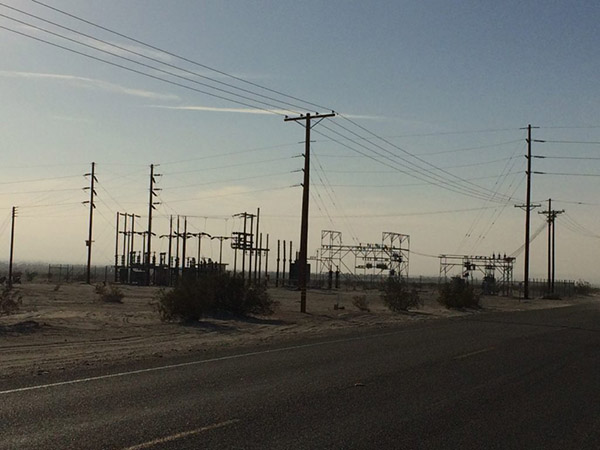
View from a desert homestead near the U.S./Mexico border, with the turbines of a wind farm visible in the distance. Photo by author.
“This is something you won’t find written down,” says George, watching intently for my reaction. “But it’s been agreed upon at the highest level of government—the highest level—that the California desert is designated as a sacrifice zone. We are worth sacrificing.” He holds my gaze, making sure I take down what he says word for word. George speaks with confidence and ease, a natural choice for the face of his neighborhood conservation group. “I’ve done the calculations. More renewable energy is available from rooftop solar in San Diego and Los Angeles Counties than will be derived from the large-scale generating facilities on two million acres of desert habitat called for in the Desert Renewable Energy Plan. It doesn’t make sense! But they don’t care, because they’ve decided that we’re a sacrifice zone.”
The flow of energy draws together disparate people and places, reactivating political divides between rural and urban, technology and tradition, land conservation and land development. High profile proposals like California’s Desert Renewal Energy Conservation Plan, or DRECP—which advocates intensive development of solar, wind, and geothermal industries in sparsely populated desert areas—claim to provide economic advantages for locals, extract value from currently unused land, and generate much-needed renewable energy to power California’s future. But detractors like George, most of whom live in those desert areas, question whether landscape-scale renewable energy plans actually prioritize the needs of California’s growing coastal cities against the needs of small rural communities, wildlife, and desert ecosystems.
Both sides of this debate reveal deep cultural logics about what constitutes environmental expertise; about human relationships to land, nature, and technology; and about what kind of future renewable energy can power, how, and for whom (or what).
I’ve heard the sacrifice zone narrative from most of the environmental activists I shadowed during my fieldwork on ecological politics in the Southern California desert. Essentially, a sacrifice zone is a geographic area that has been permanently damaged by some combination of pollution, environmental degradation, and economic failure. You may have heard the term used to refer to toxic waste dumps or nuclear fallout zones. In contemporary environmentalist discourse, however, sacrifice zones can also be prescriptive: places that have supposedly been singled out as acceptable losses in a world struggling to adapt to climate change.
Anti-DRECP activists like George argue that, instead of generating power where it’s used most, the DRECP’s reliance on traditional utility-scale power plants and overzealous land acquisition means that both pristine public wilderness and already disadvantaged rural communities will be “sacrificed” to generate energy for wealthy, unsustainable, coastal cities. By naming and arguing against the sacrifice zone model, which many see as condoning (if not actively promoting) growth for the sake of growth, they advocate instead for a conservation and efficiency-driven model based on local power. Here, local power refers to newer and more sustainable distributed energy generation technologies (such as rooftop solar) that produce energy closer to its point of use, as well as an entire ethics of justice, equity, and care for living and non-living things.

View from a geothermal power plant near the shores of California’s Salton Sea, with other power plants visible in the distance. Photo by author.
Green futures
California’s renewable energy boom is often referred to rather sardonically as the “new gold rush,” or (my personal favorite) the “green rush.” A 2015 Carnegie Institution of Science study on the impact of California’s solar energy development found 161 existing and planned projects as of May 2014, concentrated mostly in the southern Central Valley, the high Mojave Desert north and east of Los Angeles, and the Imperial Valley near the U.S./Mexico border. Lead author Rebecca Hernandez summarized the state of the boom for a press release, noting “Solar energy in developed areas, or for example on contaminated lands, would have great environmental co-benefits, but this is not what is being emphasized. Instead, we see that ‘big solar’ is competing for space with natural areas.”
And yet, to many, all this intensive development promises a new future of sustainable citizenship and energy independence, enabled by a resilient infrastructure of interlinked renewable energy producers. The Mojave and Colorado Deserts become productive places of renewable energy generation, based on their abundant, inexhaustible supplies of wind and sunlight. Here, the desert environment itself becomes part of the larger grid of California energy infrastructure, where largely uninhabited desert lands can be put to work on behalf of distant urban and suburban residents, engendering a new set of ecological and political relations that travel alongside a new set of transmission lines.
Collaborating over 5 years, a host of state and federal agencies developed the draft Desert Renewable Energy Conservation Plan, with input from scientific advisors and mainstream environmental organizations. These agency authors (dubbed the Renewable Energy Action Team, or REAT) designed the plan to move California towards that utopian energy future by correcting its history of piecemeal energy development, where individual government agencies would approve (or not approve) individual projects. Instead of making decisions based on local political climates, the draft DRECP “uses science to inform the siting of renewable energy development projects and the conservation of species, creating systematic habitat protection and connectivity improvements across the Mojave and Colorado/Sonoran desert regions” (2014:6). Based on this scientific analysis, the REAT identified “development focus areas” that could accommodate up to 20,000 megawatts of power from renewable energy projects and associated transmission over the next 25 years, in places where environmental impacts can be managed or mitigated.

An electrical substation weathers the clouds of dust kicked up by a nearby off-road vehicle recreation area. Photo by author.
Local power
For many anti-DRECP activists, the idea of “local power” encapsulates their concerns, signaling both a need for power that is local (generated as close to the point of use as possible), and the power of localism (consideration and care for the specificity and particularity of local places and people).
While most of the people I spoke with certainly had complaints about particular development focus areas, their objections had more to do with what they saw as dangerous assumptions underwriting the top-down, landscape-scale decision making approach: most notably, 1) modeling California’s energy landscape on large-scale power generation for urban areas, which privileges an old-fashioned system based on unfair business practices and unsustainable growth; 2) choosing new sites where negative impacts could be “managed,” rather than better developing existing sites and/or already disturbed urban areas; and 3) claiming that systematic science could (and should) override more nuanced considerations of local difference, local expertise and ethics.
As Diane, a long-time Sierra Club member, wrote in her comments on the DRECP draft plan, “A positive cost-benefit analysis [for renewable energy development] depends on project scale and site selection. Unpredictable weather and hot, dusty environments contribute to sub-optimal performance and longevity of solar arrays. Both are disastrous for the desert’s fragile ecosystem and wildlife. There are better alternatives than sacrificing California’s desert in order to achieve goals that are both economically and environmentally sustainable.”
We speak for the desert
For anti-DRECP activists, plans to develop large-scale power facilities were not just environmentally and economically unwise, they were completely at odds with their lived experience of how the desert works. Their desert is an extreme landscape that can’t be reduced to human models; that refuses or exceeds attempts to measure its productivity and value for human habitation. But it is also sensitive and isolated, built and sustained by extremely local relations of care, conservation, and stewardship between human and non-human actors, which is a bit of a double-edged sword.
The problem with fighting the sacrifice zone model with local power is that it’s become increasingly difficult to argue the needs of the few (in sparsely populated desert lands) against the needs of the many (in growing urban centers), particularly under the global threat of climate change. Speaking in person, Diane explains, “The risk is the DRECP defining a whole new right of way for the future. We’re the ones who have to advocate for the places no one cares about.”

1 Comment
Great matter of concern…… Excellent article.